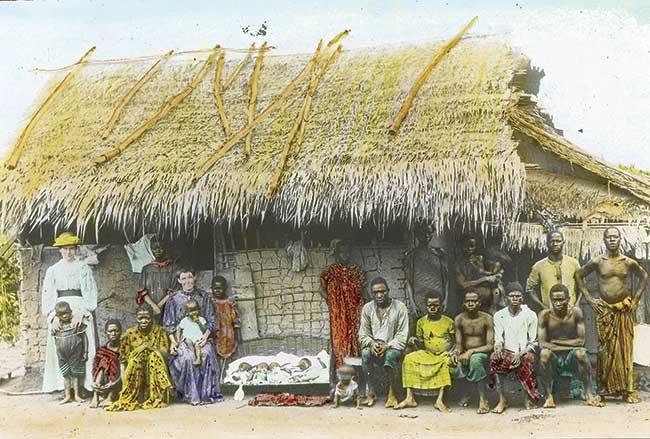The whole story

[Mary Slessor’s House at Akpap, c. 1880. International Mission Photography Archive, University of Southern California—Public domain, Wikimedia]
How does CH bring the story of the church to the people of the church? Sometimes, we tell you as much as we can! This accessible bird’s-eye view of the last 2,000 years of the church, originally published in 1990, updated here with recent scholarship, continues to be the top article on our website.
After 2,000 years Christianity is the faith, at least nominally, of one-third of the earth’s population. From a handful of fishermen, tax collectors, and youthful troublemakers in an obscure province of Judea, the faith spread over the globe to almost two billion people.
Jesus and the Apostles (0–70)
The way forward usually meant a studied look backward, back to the image of God revealed in the story of Jesus. Christians have always considered the age of Jesus and his apostles a kind of model for all the other ages. It gave to the church its faith in Jesus, the resurrected Messiah, and the hope of forgiveness of sins through him. The age demonstrated, in the life of Paul, that the gospel of grace recognizes no boundaries of nation, race, sex, or culture.
Catholic Christianity (70–312)
The catholic (universal) Christianity that accepted this truth spread rapidly throughout the Mediterranean world (see pp. 13–15). It confronted the ideas of Gnosticism, Marcionism, and Montanism and called a lie a lie by appealing to the apostolic writings and to the orthodox bishops who guarded them. At the same time, Christians faced the persecuting power of Rome and dared to die as martyrs, witnesses to other believers to follow in their train. This seed of martyr’s blood, as Tertullian called it, eventually bore abundant fruit in the empire’s conversion.
A Christian Empire (312–590)
The imperial age began in 312 when Constantine had a vision of Christ (see pp. 17–19). Before the fourth century closed, Christianity became the official religion of the sprawling Roman state. A church in the catacombs was one thing, but what does Christianity have to do
with palaces?
Under the emperor’s tutelage, the church learned to serve the seats of power by formulating the faith for the masses. Hence emerged the age of great councils. Those Christians who had no yearning for palaces headed for the wilderness in search of another way. Revered hermits soon found themselves in the vanguard of monasticism, the wave of the future.
Medieval Christendom (590–1517)
Most Christians, however, saw the hand of God in the happy wedding of Christian church and Roman state. After the fifth century, when barbarian Germans and Huns shattered the empire’s defenses and swept into the eternal city of Rome itself, people turned to Augustine’s City of God for explanations. They found a vision for a new age. We call these centuries “medieval.” The pope stepped into the ruins of the fallen empire in the West and proceeded to build the medieval church upon Rome’s bygone glory. As the only surviving link with the Roman past, the Church of Rome mobilized Benedictine monks and deployed them as missionary ambassadors to the German people. Christian rulers expanded their domains, eventually converting the continent. Centuries later Christendom extended through all Europe.
Cultural and theological tensions between the East and West led to the Great Schism of 1054 (see pp. 22–23), launching each church on different trajectories. In the Eastern Empire, Orthodoxy and mystical piety flourished for a millennium. In 1453 invading Muslim Turks brought the Byzantine Empire to its final ruin. The fall of Constantinople meant the rise of Moscow, the new capital of Eastern Orthodoxy.
By the tenth century, winds of spiritual renewal brought new life into the Western church. It started in a monastery in central France called Cluny and spread until it reached the papacy itself. The greatest of the reforming popes was Gregory VII. His zealous successors carried the papal office to the zenith of earthly power. The twelfth-century church was itself a kind of empire, a spiritual and earthly kingdom stretching from Ireland to Palestine, from earth to heaven. The Crusades and scholastic philosophy were witnesses to this papal sovereignty.
The Roman Catholic Church experienced all the challenges and blessings of a Christian empire. Popes both resisted and manipulated the powers of nation-states. Protoreformers like the Waldensians, Franciscans, and Albigensians spurred change and sparked conflict. Waves of plagues and wars diminished the population. Still, contrary to modern misconceptions, intellectual and spiritual life flourished, and the seed of believers seeking fresh vision and renewal would lead to a new era in the West.
Spark of the Reformation (1517–1648)
Reform came with a fury. Martin Luther (see pp. 28–31)sounded the trumpet, but hosts of others rallied to the cause. This period marks the mobilization of Protestantism: Lutheran, Reformed, Anglican, and Anabaptist. By the mid-sixteenth century, the Reformation had shattered the traditional unity of western Europe and had bequeathed to modern times religious pluralism. The Church of Rome responded with force but also with reform, leading to the Society of Jesus (see p. 32). Missionaries went to Asia, Africa, and Latin America. Catholics and Protestants alike warred in France, the Netherlands, and Germany. The denominational concept of the church arose, which allowed modern nations to treat the churches as voluntary societies separated from the state.
Reason and Revival (1648–1789)
Novel schools of thought filled the seventeenth century. None was more powerful than Reason itself. It asked, “Who needs God? Man can make it on his own.” Christians screamed objections, but the idea spread until secularism filled the public life of Western societies. God remained only as a matter of personal choice. Christians could no longer appeal to the arm of power to suppress such heresies. So many of them turned instead to the apostles’ way—prayer and preaching. The result was a series of evangelical revivals: chiefly Pietism, Methodism, and the Great Awakening. Through preaching and personal conversions, evangelicals tried to restore God to public life.
Tech And secularization (1789–1914)
The age of progress saw Christians of all sorts wage a valiant struggle against the advance of secularism. New efforts to carry the gospel of Christ to distant lands began, as well as many social service ministries in industrialized Europe and North America. From the ramparts of Rome, a defensive papacy fired a barrage of missiles aimed at the modern enemies of the Catholic faith. Despite best efforts, however, Christianity was slowly driven from public life in the Western world. Believers were left with the problem we recognize in our own time: how can Christians exert moral influence in pluralistic and totalitarian societies where Christian assumptions about reality no longer prevail?
Ideological idols (1914–1990)
The depth of the problem was apparent in the age of ideologies, when new gods arose to claim the loyalties of secular people. Nazism exalted the state; communism worshiped the party; and American democracy revered the individual’s rights. Supposed enlightened, modern nations waged two global wars in an attempt to establish the supremacy of these new deities. When no single ideology prevailed, a cold war of coexistence settled upon the once Christian nations. Through these troubled times, the denominations struggled over orthodox and liberal theologies, sought fresh ways to recover a lost unity, and reflected a new hunger for apostolic experiences.
After World War II, vigorous new Christian leadership emerged in the Third World, offering fresh hope for a new day for the old faith. Had missionaries from Europe and North America succeeded in giving Christianity a stake in the future by carrying the gospel to Africa and Latin America? Only time will tell.
But Christians can hope because faith always reaches beyond earthly circumstances. Its confidence is in a person. And no other person in recorded history has influenced more people in as many conditions over so long a time as Jesus Christ. The shades and tones of his image seem to shift with the needs of people: the Jewish Messiah of the believing remnant, the Wisdom of the Greek apologist, the Cosmic King of the imperial church, the Heavenly Logos of the orthodox councils, the World Ruler of the papal courts, the monastic Model of apostolic poverty, the personal Savior of evangelical revivalists.
Truly he is a man for all time. In a day when many regard him as irrelevant, a relic of a quickly discarded past, church history provides a quiet testimony that Jesus Christ will not disappear from the scene. His title may change, but his truth endures for all generations. —Bruce L. Shelley, from CH #28 CH
By Bruce Shelley
[Christian History originally published this article in Christian History Issue #150 in 2024]
Bruce L. Shelley (1927–2010) was professor of church history and historical theology at Denver Seminary. He wrote or edited over 20 books.Next articles
Missions and martyrs
Some episodes from the early church
Edwin Yamauchi, William G. Bixler, J. Warren SmithThe emperor, the healer, and the teacher
Constantine, Basil, Augustine
David F. Wright, Timothy S. Miller, Dan GravesSupport us
Christian History Institute (CHI) is a non-profit Pennsylvania corporation founded in 1982. Your donations support the continuation of this ministry
Donate







